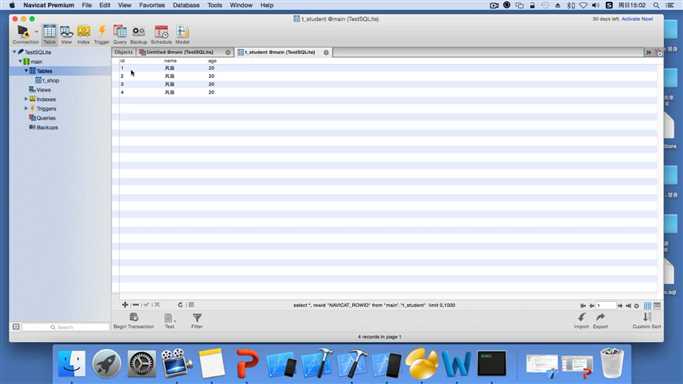标签:
---恢复内容开始---
数据库 增 删 改 查 这是数据库中做的最多的
inster delete update select
在数据库中创建和删除表(create table 和 drop table)
常用的关键字 还有where , order by ,group by 和having,limit
create table if not exists 表名 (字段名1 字段类型1, 字段名2 字段类型2, …) ;
示例
create table t_student (id integer, name text, age inetger, score real) ;
如果有t_student就不创建,如果没有这个表则创建
create table if not exists t_student (id integer, name text, age inetger, score real)
SQLite将数据划分为以下几种存储类型:
integer : 整型值
real : 浮点值
text : 文本字符串
blob : 二进制数据(比如文件)
删除表
格式
drop table 表名 ;
drop table if exists 表名 ;
示例
drop table t_student ;
插入数据
格式
insert into 表名 (字段1, 字段2, …) values (字段1的值, 字段2的值, …) ;
示例
insert into t_student (name, age) values (‘mj’, 10) ;
注意
数据库中的字符串内容应该用单引号 ’ 括住
更新数据
格式
update 表名 set 字段1 = 字段1的值, 字段2 = 字段2的值, … ;
示例
update t_student set name = ‘jack’, age = 20 ;
注意
上面的示例会将t_student表中所有记录的name都改为jack,age都改为20
删除数据
delete from 表名 ;
示例
delete from t_student ;
注意
上面的示例会将t_student表中所有记录都删掉
条件语句
where
如果只想更新或者删除某些固定的记录,那就必须在DML语句后加上一些条件
条件语句的常见格式
where 字段 = 某个值 ; // 不能用两个 =
where 字段 is 某个值 ; // is 相当于 =
where 字段 != 某个值 ;
where 字段 is not 某个值 ; // is not 相当于 !=
where 字段 > 某个值 ;
where 字段1 = 某个值 and 字段2 > 某个值 ; // and相当于C语言中的 &&
where 字段1 = 某个值 or 字段2 = 某个值 ; // or 相当于C语言中的 |
示例
将t_student表中年龄大于10 并且 姓名不等于jack的记录,年龄都改为 5
update t_student set age = 5 where age > 10 and name != ‘jack’ ;
删除t_student表中年龄小于等于10 或者 年龄大于30的记录
delete from t_student where age <= 10 or age > 30 ;
查询
格式
select 字段1, 字段2, … from 表名 ;
select * from 表名; // 查询所有的字段
示例
select name, age from t_student ;
select * from t_student ;
select * from t_student where age > 10 ; // 条件查询
起别名
格式(字段和表都可以起别名)
select 字段1 别名 , 字段2 别名 , … from 表名 别名 ;
select 字段1 别名, 字段2 as 别名, … from 表名 as 别名 ;
select 别名.字段1, 别名.字段2, … from 表名 别名 ;
示例
select name myname, age myage from t_student ;
给name起个叫做myname的别名,给age起个叫做myage的别名
select s.name, s.age from t_student s ;
给t_student表起个别名叫做s,利用s来引用表中的字段
计算记录的数量
格式
select count (字段) from 表名 ;
select count ( * ) from 表名 ;
示例
select count (age) from t_student ;
select count ( * ) from t_student where score >= 60;
排序
查询出来的结果可以用order by进行排序
select * from t_student order by 字段 ;
select * from t_student order by age ;
默认是按照升序排序(由小到大),也可以变为降序(由大到小)
select * from t_student order by age desc ; //降序
select * from t_student order by age asc ; // 升序(默认)
也可以用多个字段进行排序
select * from t_student order by age asc, height desc ;
先按照年龄排序(升序),年龄相等就按照身高排序(降序)
取值
使用limit可以精确地控制查询结果的数量,比如每次只查询10条数据
格式
select * from 表名 limit 数值1, 数值2 ;
示例
select * from t_student limit 4, 8 ;
可以理解为:跳过最前面4条语句,然后取8条记录
limit常用来做分页查询,比如每页固定显示5条数据,那么应该这样取数据
第1页:limit 0, 5
第2页:limit 5, 5
第3页:limit 10, 5
…
第n页:limit 5*(n-1), 5
约束********************************
建表时可以给特定的字段设置一些约束条件,常见的约束有
not null :规定字段的值不能为null
unique :规定字段的值必须唯一
default :指定字段的默认值
(建议:尽量给字段设定严格的约束,以保证数据的规范性)
示例
create table t_student (id integer, name text not null unique, age integer not null default 1) ;
name字段不能为null,并且唯一
age字段不能为null,并且默认为1
外键约束
利用外键约束可以用来建立表与表之间的联系
外键的一般情况是:一张表的某个字段,引用着另一张表的主键字段
新建一个外键
create table t_student (id integer primary key autoincrement, name text, age integer, class_id integer, constraint fk_student_class foreign key (class_id) references t_class (id));
t_student表中有一个叫做fk_t_student_class_id_t_class_id的外键
这个外键的作用是用t_student表中的class_id字段引用t_class表的id字段

如果指定id 为主键 则表中会自动添加序列号。
标签:
原文地址:http://www.cnblogs.com/lizhan1991/p/4875539.html